Edition S
back to HIFIMAN
back to measurements
home
published: Jul-19-2017, updated: Apr-8-2019
NO SMOOTHING is applied to the shown plots. Most measurement sites have some smoothing applied which ‘irons flat’ sharp peaks and ‘wiggles’. I do not use smoothing because some info about sound quality is lost when plots are smoothed.
Aside from a small correction of the microphone itself also some correction in the lowest frequencies is applied to the plots to compensate for the perceived loss of bass when using headphones. This is described HERE in more detail.
A ‘horizontal‘ frequency response curve on the shown frequency response plots on this website thus indicates a perceived ‘flat’ tonal signature.
ALL measurements are made with a good SEAL on a flatbed measurement rig.
The shape of your head, bone structure, pad size, pad ‘softness, (compliance), hair or no hair and or wearing glasses may (drastically) change the frequency response of some headphones, so… your personal experience may differ substantially from these plots.
Frequency response (tonal balance) is the most sound-determining aspect of headphones. A horizontal line shows audible neutral response in the plots on this website. Deviations in different severities at different frequency bands have an effect on the sound character.
The bigger the deviation the stronger the effect.
Below an aid to help determining the sound character of headphones with relation to the frequency response.

HIFIMAN Edition S

The HIFIMAN Edition S is a dynamic over-ear headphone. A feature of this headphone is that it can be used as an open and as closed headphone. It comes in 2 colors, black and white. It retails for around € 250.- .
This headphone is designed to be driven from portable equipment.
Comfort is good, the clamping force is high but because of the large pads the pressure is well distributed and ensures a good seal.
The weight of this headphone is ‘medium’ so not a lightweight nor a heavy headphone.
It does play quite loud on low powered portable sources such as phones and tablets as well as cheap small MP3 players.
specifications:
Type: Over ear, open & closed
Usage: Home, portable, office
Driver type: dynamic
Pads: replaceable, hybrid pleather/velours (Focus pads)
Inner pad dimensions: depth: 19mm. height: 60mm, width 30mm almost rectangular shaped.
Collapsible: Yes
Headphone connector: 3,5mm TRS
Cable entry: single sided (left)
Cable: replaceable 1.3m with gold plated 3.5mm TRRS plug with inline mic/remote.
Driver size: 50 mm
Nom. power rating: unknown (assumed 0.2W)
Max. voltage: 1.9V (assumed 0.2W)
Max. current: 100mA (0.1A) (assumed 0.2W)
Max. S.P.L. 118dB (assumed 0.2W)
Impedance: 18 Ω
Efficiency: 95dB @ 1mW
Sensitivity: 113dB @ 1V
Weight: 248 g.
Clamping force: high
Accessories: carrying case, airplane adapter, 6.3mm adapter.
Sound description:
Closed: Bassy and ‘hollow’ sound. Mids are sucked out and have an unreal character by having a ‘full body’ and sounding ‘thin’ at the same time. The sound lacks ‘dynamics’ and is a bit compressed. The treble has a sharp character and is elevated.
Open: The sound becomes a bit more bassy sounding but the mid-bass is ‘muddy’.
Mids are even more sucked out and sound ‘hollow’. The sound is too ‘laid back’ and is lacking in presence and clarity. The treble has a sharp character and is elevated.
measurements:
The upper part of this article covers the response in closed mode of operation
Below the frequency response of the Edition S closed (Left, Right)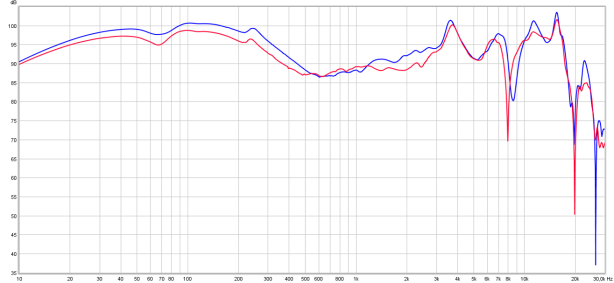
The channel balance is not very good compared to most other measured HIFIMAN headphones. At some frequencies the differences even reach 4dB. The tonal balance is ‘bassy’ with quite present treble. It is slightly ‘scooped’ in the mids. It does have good clarity. Bass extension is good, so is the treble extension.
As this headphone can also be used in open configuration below the difference in frequency response (left channel only) between open and closed.
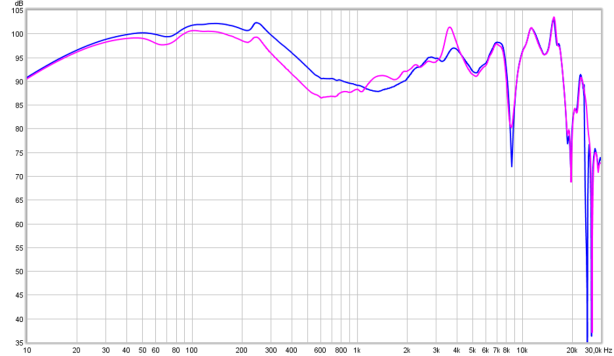
When open the lower mids are attenuated a bit more and clarity is a bit lower. In closed mode the headphone sounds a little clearer and less ‘warm-ish/fat-ish’ in comparison.
Below the distortion measurements of the Edition S closed (Right channel).
Note that this headphone was measured at ![]() where background noises were present in the demo room. As this is an reasonably closed headphone the distortion levels and spectrum plot performance may thus be somewhat better in reality than as shown on the plots due to ambient sounds being measured along with the headphone.
where background noises were present in the demo room. As this is an reasonably closed headphone the distortion levels and spectrum plot performance may thus be somewhat better in reality than as shown on the plots due to ambient sounds being measured along with the headphone.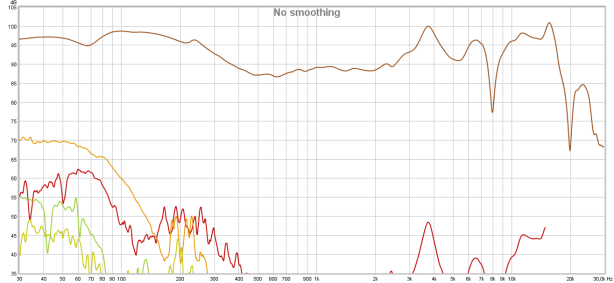
The distortion plots are typical for dynamic headphones as below 200Hz the distortion is higher. Especially the 3rd harmonics as well as the 2nd harmonics. The higher 3rd harmonics point towards non-linearities leading to some compression in the lows.
The 3rd harmonics reach 5% in the lows which is quite mediocre. The distortion peaks around 200Hz are (possibly) caused by ambient noises or the side plates which ‘close’ the headphone. In reality the distortion may be lower there or may not be.
Above 500Hz the distortion levels look good. The peak at 4 kHz barely exceeds 0.2%.
Below the same distortion plot but displayed in percentages.
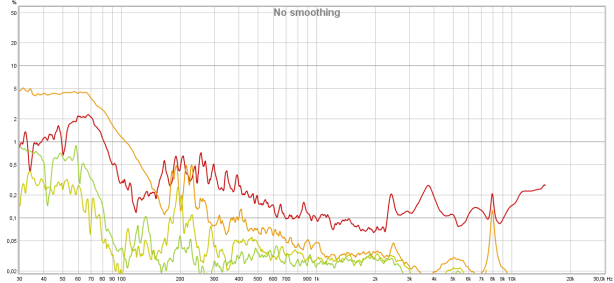
Below the CSD of the Edition S closed (Left and Right are superimposed)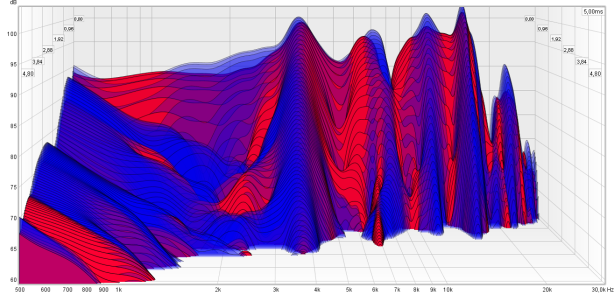
At 4kHz there is some short lived ringing. This is benign as the ear canal resonates at this frequency as well. At higher frequencies there are some very narrow and short lived resonances which don’t look problematic.
output resistance / damping-factor
As this is a low impedance dynamic headphone the frequency response might be amplifier output resistance dependent when certain higher output resistance amplifiers are used. In the high-end desktop amp world chances are higher that you can encounter a high output resistance amplifier.
To test this the headphone is measured via a low impedance amplifier (0.2Ω) and a high impedance amplifier (120Ω). On a higher output resistance amplifier the output level will be slightly lower. To compensate for this the amplifier is cranked up a bit to the same level (at 1kHz) as the low impedance amplifier. This way the plots are overlay-ed and it is easy to see how the tonal balance changes.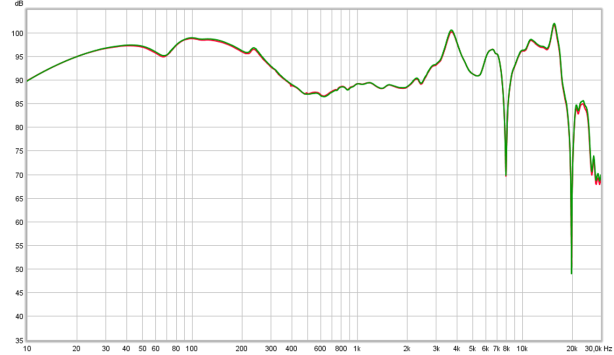
It looks like a higher output resistance of the amplifier (or portable equipment) has no influence at all on the tonal balance. The impedance plot thus is very ‘flat’.
Below the spectrum plot of the Edition S closed. 
Between 2kHz to 4kHz some short lived ringing is visible. This isn’t audible though as it will be ‘masked’ by the ear-canal’s own ringing anyway. The rest of the plots looks quite good. The bass does ‘linger on’ a bit longer than desirable though.
The step response (Right channel) below shows the bass is a bit elevated but well extended. The resonances are short lived but are not very low in amplitude. The higher frequencies seem to be damped a bit better than at 3kHz . Impulse response is at the proper level though so there is a good impulse response.

The left channel shows a similar pattern and thus not shown.
HIFIMAN Edition S (open)

The HIFIMAN Edition S can also be used with the side shields removed. The headphone becomes more of an open headphone this way. The shields are sticking to a metal grill by the aid of a magnet. This works quite well. With the shields removed the tonal balance changes and people around you can hear what you are playing and you are more aware of ambient sounds.
When in ‘closed’ operation outside noises are more attenuated but not at the level of a good sealed headphone.
Sound description:
Will be added later
measurements:
This part of this article covers the response in open mode of operation.
Below the frequency response of the Edition S open (Left, Right)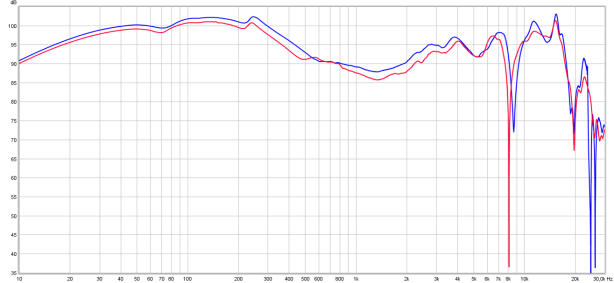
The channel balance is not very good compared to most other measured HIFIMAN headphones. At some frequencies the differences reach 2dB. In closed operation the channel difference are bigger though. The tonal balance is ‘bassy’ an ‘warm’ bordering on a bit ‘fat’ sounding with good clarity and treble. It is slightly ‘scooped’ in the mids. I does have good clarity. The sharp ‘null’ around 8kHz seems to be a driver issue (cone break-up ?) Bass extension is good, so is the treble extension. Sub-bass rolls of seemingly higher due to the higher level of (mid-bass).
As this headphone can also be used in closed configuration below the difference in frequency response (left channel only) between open and closed.

When open the lower mids are attenuated a bit more and clarity is a bit lower. In closed mode the headphone sounds a little clearer and less ‘warm-ish/fat-ish’ in comparison.
Below the distortion measurements of the Edition S open (Left channel).
In the measurements of the closed version the right channel measurements were shown.
Note that this headphone was measured at ![]() where background noises may have been present in the demo room. As this is an open headphone the distortion levels and spectrum plot performance may thus be better in reality than as shown on the plots due to ambient sounds being measured along with the headphone. In this particular case it was very quiet in the room.
where background noises may have been present in the demo room. As this is an open headphone the distortion levels and spectrum plot performance may thus be better in reality than as shown on the plots due to ambient sounds being measured along with the headphone. In this particular case it was very quiet in the room.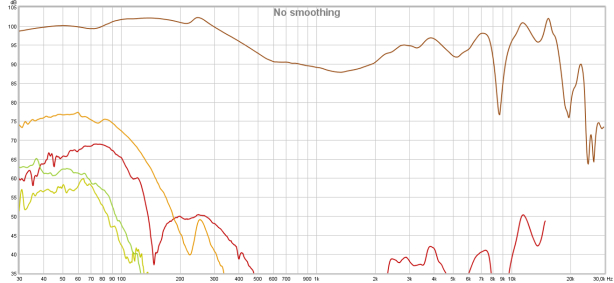
The distortion plots are typical for dynamic headphones as below 200Hz the distortion is higher. Especially the 3rd order harmonics as well as the 2nd order harmonics. The higher 3rd harmonics point towards non-linearities leading to some compression in the lows.
The 3rd harmonics reach 7% in the lows which is quite mediocre.
Above 200Hz the distortion levels look good. The peak at 4 kHz barely exceeds 0.2%.
At 8.5kHz there is some 3rd harmonic distortion reaching 0.2% pointing towards a driver problem. This is very low in amplitude though.
Below the same distortion plot but displayed in percentages.

Below the CSD of the Edition S open (Left and Right are superimposed)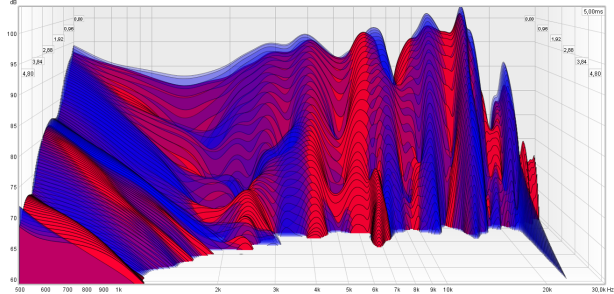
There are less resonances in ‘open’ mode. Perhaps the metal shield that closes the headphone could/would have to be damped a bit better ?
Around 23kHz there is some very narrow ringing visible. This isn’t present in the right driver. It isn’t an issue though.
Below the spectrum plot of the Edition S open. 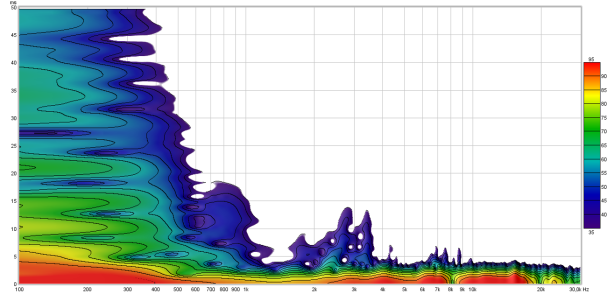
Between 2kHz to 4kHz some short lived ringing is visible. This isn’t audible though as it will be ‘masked’ by the ear-canal’s own ringing anyway. The rest of the plots looks quite good. The bass does ‘linger on’ a bit longer than desirable though.
The step response (Right channel) below shows the bass is a bit elevated and a tad less well extended as when being ‘closed’. The resonances are short lived but are not very low in amplitude. The higher frequencies seem to be damped a bit better than at 3kHz . Impulse response is at the proper level though so there is a good impulse response.

The left channel shows a similar pattern and thus not shown.
summary
Fit and finish, comfort, weight are decent/good. The pads and headband feel comfortable. The sound signature is slightly scooped/lacking some warmth in voices. Clarity of instruments and voices is good though. Treble is of good quality and not splashy nor sibilant. A colored sounding headphone with only some slight niggles. The open/closed option is more a gimmick than anything else. The attenuation of outside noises isn’t as good as a closed headphone.
In this price class I would look around a bit more. There are better sounding options available at this price.
